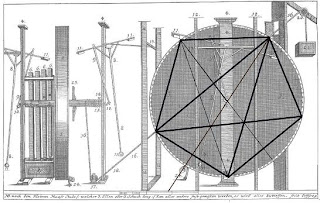Occasionally I've commented on Bessler's graphic codes, but have generally said little about the non-graphic ones. But as the subject of the infamous x's scattered throughout Apologia Poetica, came up recently on Besslerwheel forum, I thought I'd update people on my own efforts to extract meaning from them. I know this is not as interesting as discussing possble mechanical arrangements but there are many people who are still bent on deciphering what Bessler's secret message said.
The mysterious inclusion of 684 x’s scattered in an apparently random fashion at the ends of many of the 7000 plus lines of poetry which compose the Apologia Poetica, has been the subject of some debate. In fact these
x’s are actually abbreviations for the phrase
et cetera, and one might think that that is a satisfactory explanation for their presence, but 684 seems an excessive use of the Latin expression and their numbers are reduced to a normal amount, less than ten, in his subsequent book, Das Triumphirende. The presence of 28
&c's in addition to the
et ceteras used, would seem to make the necessity of using the Latin abbreviation redundant, anyway.
The presence of so many
et ceteras and the various hints at the existence of a hidden message within the Apologia Poetica lead one inevitably to question the large number of these abbreviations. In some cases there are as many as seven consecutive lines each ending in the Latin expression.
There are 397
et ceteras in part one of Apologia Poetica, and 287 in part two, totalling 684. I have omitted the
&c's and the many
NB’s and
NB’s because I am uncertain about their relevance to a secret message. But just for the record there are 9 + 19 = 28 &c’s, and 20 + 176 = 196 NB’s. Anyway in preparation for devising his code, Bessler must have written his text and then looked for a way to hide it within his existing work. I assumed that he then circled or underlined the letters or words he sought for his text and then used some method to identify the line containing that letter or word. I suggest that he marked this line by placing the
et cetera sign at the end of it. There is no mileage, in my opinion, in trying to read something in the positioniong of these abbreviations, either from the front or the back of the page; their positioning is too similar to each other for any one to detect any subtle differences.
The next step was to leave some means of guiding us to the correct letter or word on that line. I tried various ways of identifying a letter or word, but came to the conclusion that a letter was too time consuming and as he had a plethora of suitable words to pick from, why make his job more difficult if he could use full words and still hide them. If one assumes an average of five letters per word then from a total of 684 ‘et ceteras’, he had about 137 words to complete his secret message, whereas if each et cetera indicated a whole word he would have potentially 684! I suspect the answer lies somewhere between those two figures.
The method he used to hide his words had to be very strong. This becomes even more obvious when you consider such passages as this one on page 27 of the Apologia Poetica, which has no fewer than six consecutive lines with the et cetera 'X' at the end.
If each lines contained a word from his text in the order in which it naturally ocurred, it would not take long to find the identifier and hence the whole coded message could be read. And that is not the only page containing six or more consecutive lines with et ceteras at their ends. An additional clue may be found in the presence of double et ceteras which appear in part two of Apologia Poetica. Here are a couple below:-
Note the second one is positioned just after two blanks. The missing word is ‘Schelmen’ meaning ‘rogue’ or ‘rascall’. For further information on the use of the blanks visit my web site at
www.theorffyreuscode.com
I then wondered if the meaning and even the position of the et ceteras themselves were irrelevant. Maybe the secret lay in the number of them per page. If there was just one et cetera on a page, maybe that meant 'line one' held the missing word. As a check I looked at the title page which has one et cetera on it and assumed ‘one’ et cetera meant line ‘one’. The first word is ORFFYREI which looks promising, but then it all goes wrong again. In the subsequent page with et ceteras on it, nothing else supports this idea. I tried various alternatives such as counting lines from the top on odd pages and from the bottom on even ones, but no dice.
But consider this, if each page which has one or more et ceteras on it, is meant to hide one complete word, there are potentially 226 words. That is the number of pages which have et ceteras on them. I feel that this way lies the solution. It is too tempting to be drawn into considering the line with the et cetera on it rather than just counting how may X's there are and using that number to find the word.
One more thing might be worth taking into account. The whole book is written in rhyming couplets except for part of Chapter 55, which I have discussed at
www.orffyreus.net - maybe there is some way to assign the number of et ceteras to a couplet?
Good luck to those who are persuing this line of enquiry, and I know there are several, from my email correspondence.
JC
10a2c5d26e15f6g7h10ik12l3m6n14o14r5s17tu6v5w4y4-3,’.

.jpg)










